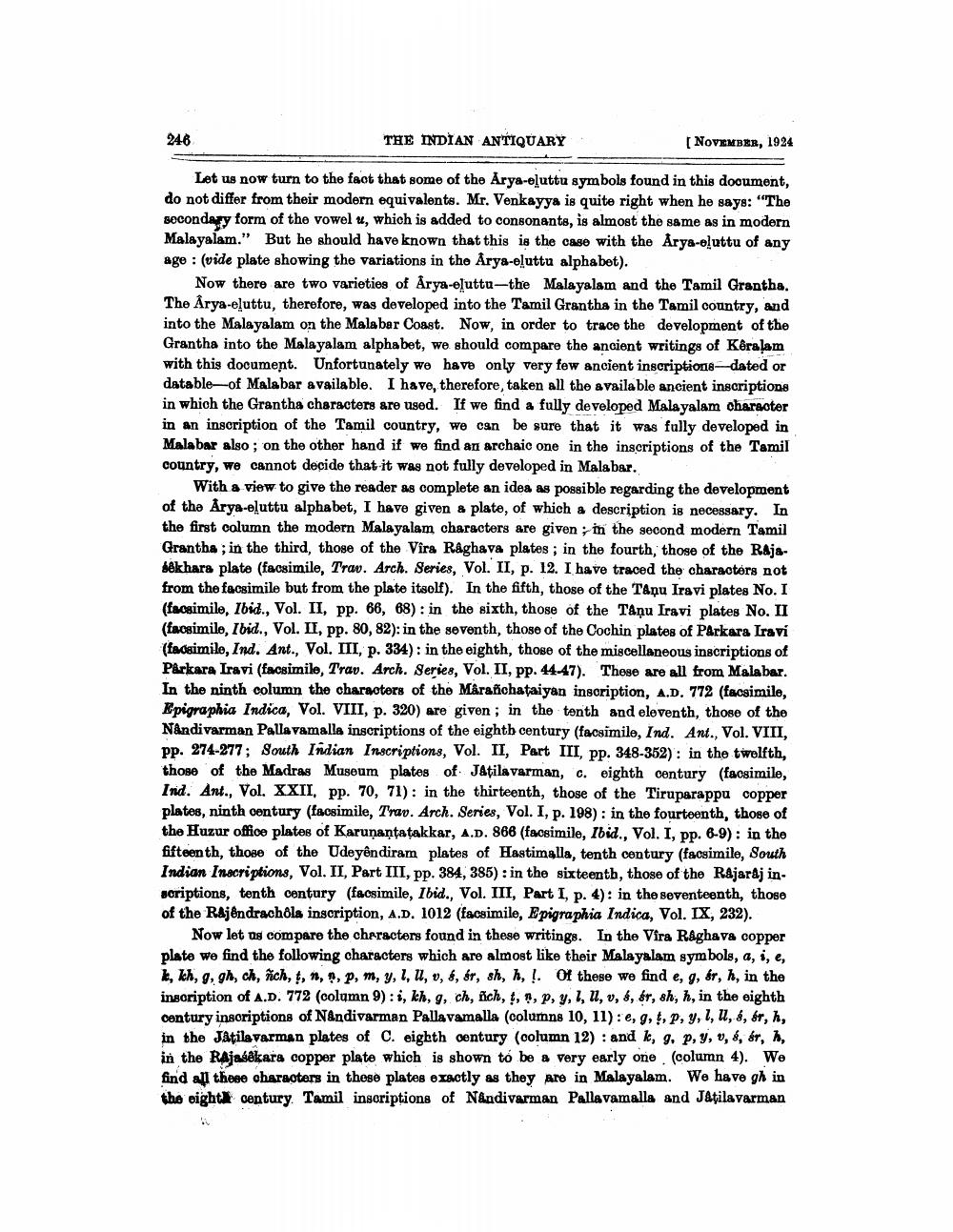________________
THE INDIAN ANTIQUARY
Let us now turn to the fact that some of the Arya-eluttu symbols found in this document, do not differ from their modern equivalents. Mr. Venkayya is quite right when he says: "The secondary form of the vowel u, which is added to consonants, is almost the same as in modern Malayalam." But he should have known that this is the case with the Arya-eluttu of any age: (vide plate showing the variations in the Arya-eluttu alphabet).
246
[NOVEMBER, 1924
Now there are two varieties of Arya-eluttu-the Malayalam and the Tamil Grantha. The Arya-eluttu, therefore, was developed into the Tamil Grantha in the Tamil country, and into the Malayalam on the Malabar Coast. Now, in order to trace the development of the Grantha into the Malayalam alphabet, we should compare the ancient writings of Keralam with this document. Unfortunately we have only very few ancient inscriptions-dated or datable of Malabar available. I have, therefore, taken all the available ancient inscriptions in which the Grantha characters are used. If we find a fully developed Malayalam character in an inscription of the Tamil country, we can be sure that it was fully developed in Malabar also; on the other hand if we find an archaic one in the inscriptions of the Tamil country, we cannot decide that it was not fully developed in Malabar.
With a view to give the reader as complete an idea as possible regarding the development of the Arya-eluttu alphabet, I have given a plate, of which a description is necessary. In the first column the modern Malayalam characters are given; in the second modern Tamil Grantha; in the third, those of the Vira Raghava plates; in the fourth, those of the Rajaéékhara plate (facsimile, Trav. Arch. Series, Vol. II, p. 12. I have traced the characters not from the facsimile but from the plate itself). In the fifth, those of the Tanu Iravi plates No. I (facsimile, Ibid., Vol. II, pp. 66, 68): in the sixth, those of the Tâņu Iravi plates No. II (facsimile, Ibid., Vol. II, pp. 80, 82): in the seventh, those of the Cochin plates of Parkara Iraví (facsimile, Ind. Ant., Vol. III, p. 334): in the eighth, those of the miscellaneous inscriptions of Parkara Iravi (facsimile, Trav. Arch. Series, Vol. II, pp. 44-47). These are all from Malabar. In the ninth column the characters of the Mârañchataiyan inscription, A.D. 772 (facsimile, Epigraphia Indica, Vol. VIII, p. 320) are given; in the tenth and eleventh, those of the Nandivarman Pallavamalla inscriptions of the eighth century (facsimile, Ind. Ant., Vol. VIII, pp. 274-277; South Indian Inscriptions, Vol. II, Part III, pp. 348-352): in the twelfth, those of the Madras Museum plates of Jatilavarman, c. eighth century (facsimile, Ind. Ant., Vol. XXII, pp. 70, 71): in the thirteenth, those of the Tiruparappu copper plates, ninth century (facsimile, Trav. Arch. Series, Vol. I, p. 198): in the fourteenth, those of the Huzur office plates of Karunantaṭakkar, A.D. 866 (facsimile, Ibid., Vol. I, pp. 6-9) in the fifteenth, those of the Udeyêndiram plates of Hastimalla, tenth century (facsimile, South Indian Inscriptions, Vol. II, Part III, pp. 384, 385): in the sixteenth, those of the Rajaraj inscriptions, tenth century (facsimile, Ibid., Vol. III, Part I, p. 4): in the seventeenth, those of the Rajendrachôla inscription, A.D. 1012 (facsimile, Epigraphia Indica, Vol. IX, 232).
:
Now let us compare the characters found in these writings. In the Vira Raghava copper plate we find the following characters which are almost like their Malayalam symbols, a, i, e, k, kh, g, gh, ch, ñch, t, n, n, p, m, y, l, u, v, é, ér, sh, h, !. Of these we find e, g, ér, h, in the inscription of A.D. 772 (column 9):i, kh, g, ch, ñch, t, n, p, y, l, ll, v, é, ér, sh, h, in the eighth century inscriptions of Nandivarman Pallavamalla (columns 10, 11): e, g, t, p, y, l, U, é, ér, h, in the Jatilavarman plates of C. eighth century (column 12): and k, g. p, y, v, é, ár, h, in the Rajasekara copper plate which is shown to be a very early one (column 4). We find all these characters in these plates exactly as they are in Malayalam. We have gh in the eight century. Tamil inscriptions of Nandivarman Pallavamalla and Jâţilavarman




